Report: Starbucks' Challenges and Failures in Australian Market
VerifiedAdded on 2022/10/09
|19
|4453
|22
Report
AI Summary
This report delves into the reasons behind Starbucks' struggles in the Australian market. It begins with an executive summary and an introduction, defining market failure and its relevance to Starbucks' situation. The discussion explores the lack of adaptability to Australian consumers, highlighting the importance of understanding local preferences and the competitive landscape. It examines potential solutions, including strategic partnerships, technological advancements, and internal organizational restructuring. The report also considers issues like substitute products, rapid expansion strategies, and the NextGen Cup Challenge initiative with McDonald's. It analyzes the failure due to rapid extension and provides recommendations for improvement, including strategic alliances, localized branding, and financial management. The report concludes by summarizing the key factors contributing to Starbucks' challenges in Australia and offering insights for future success, drawing from the provided references.
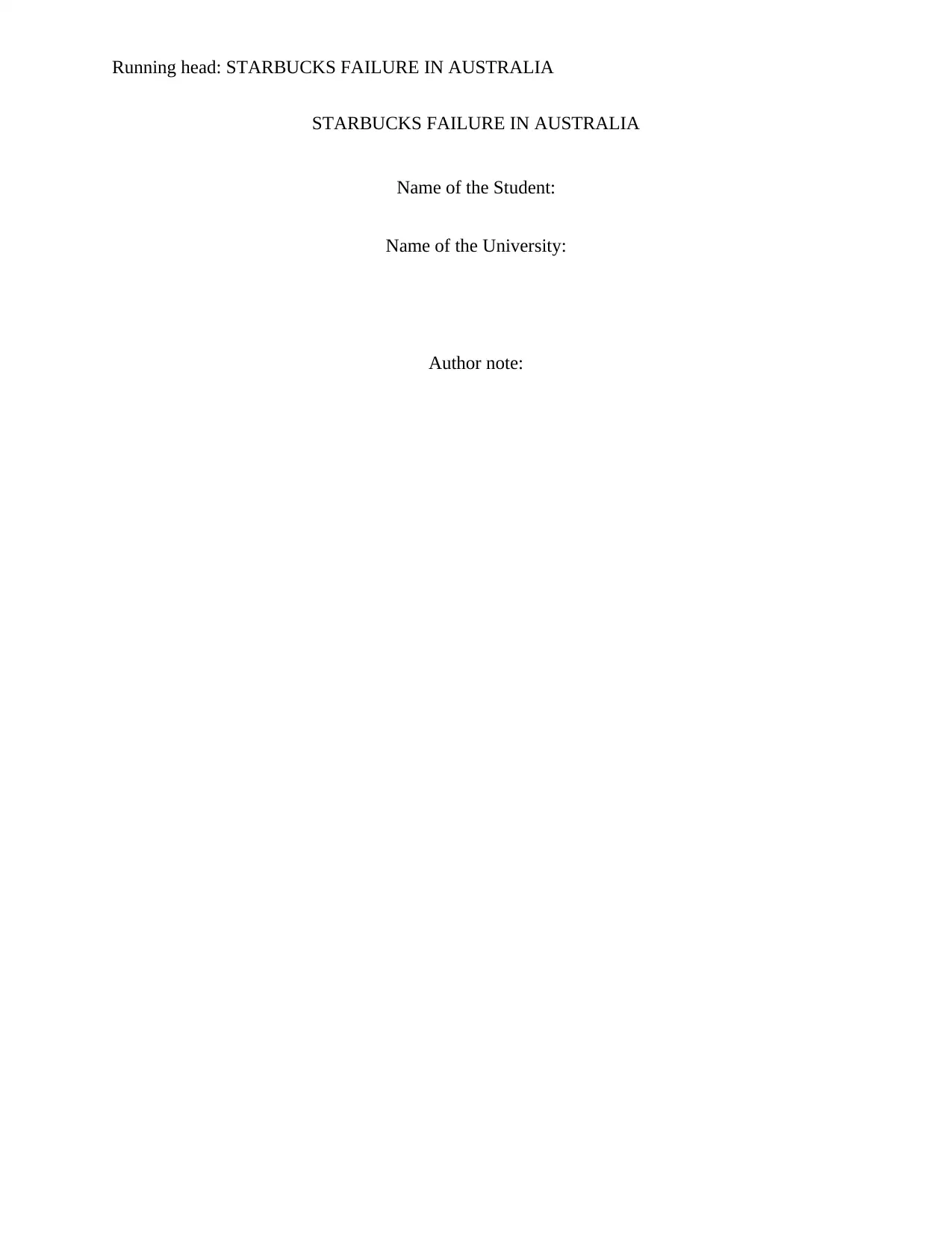
Running head: STARBUCKS FAILURE IN AUSTRALIA
STARBUCKS FAILURE IN AUSTRALIA
Name of the Student:
Name of the University:
Author note:
STARBUCKS FAILURE IN AUSTRALIA
Name of the Student:
Name of the University:
Author note:
Paraphrase This Document
Need a fresh take? Get an instant paraphrase of this document with our AI Paraphraser
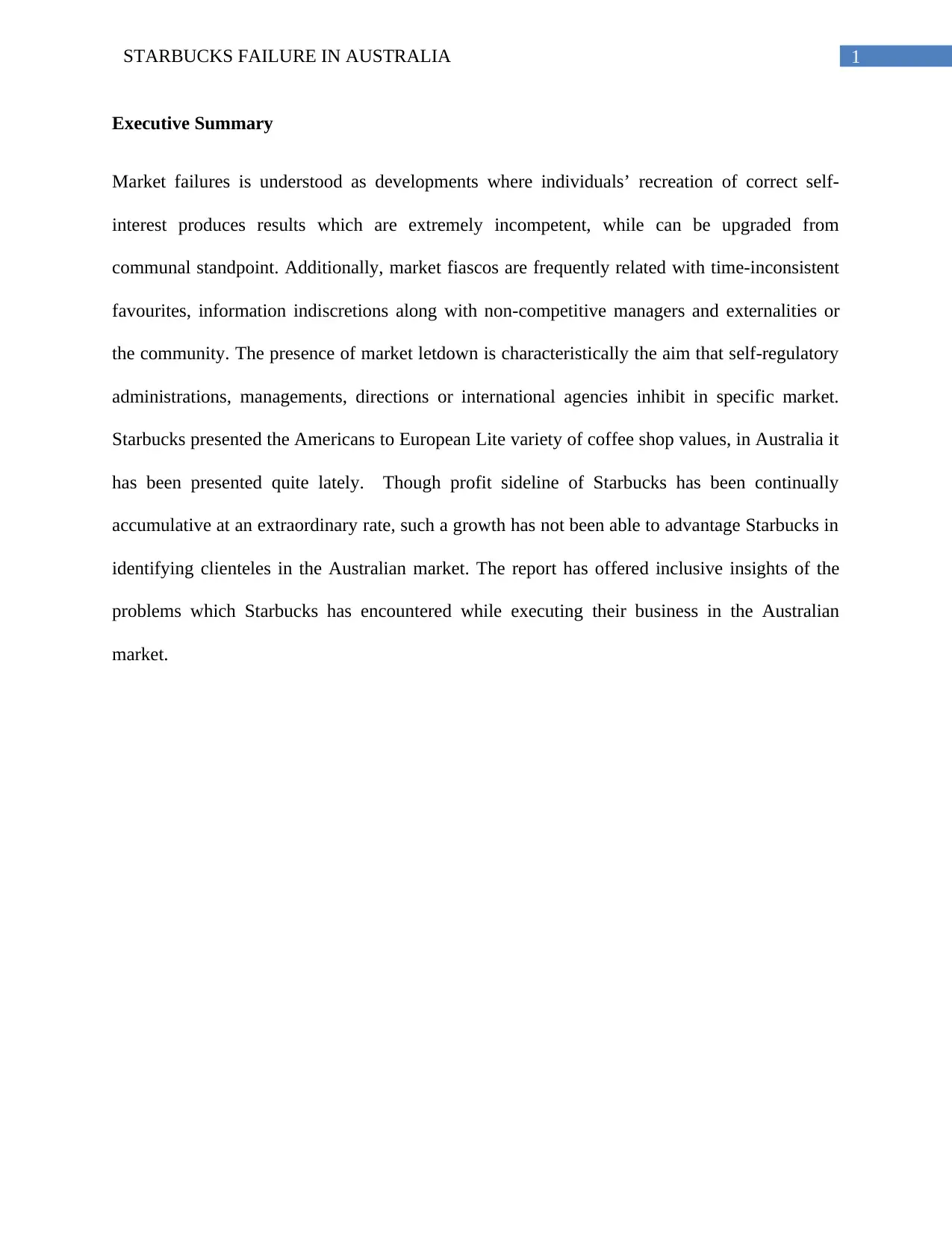
1STARBUCKS FAILURE IN AUSTRALIA
Executive Summary
Market failures is understood as developments where individuals’ recreation of correct self-
interest produces results which are extremely incompetent, while can be upgraded from
communal standpoint. Additionally, market fiascos are frequently related with time-inconsistent
favourites, information indiscretions along with non-competitive managers and externalities or
the community. The presence of market letdown is characteristically the aim that self-regulatory
administrations, managements, directions or international agencies inhibit in specific market.
Starbucks presented the Americans to European Lite variety of coffee shop values, in Australia it
has been presented quite lately. Though profit sideline of Starbucks has been continually
accumulative at an extraordinary rate, such a growth has not been able to advantage Starbucks in
identifying clienteles in the Australian market. The report has offered inclusive insights of the
problems which Starbucks has encountered while executing their business in the Australian
market.
Executive Summary
Market failures is understood as developments where individuals’ recreation of correct self-
interest produces results which are extremely incompetent, while can be upgraded from
communal standpoint. Additionally, market fiascos are frequently related with time-inconsistent
favourites, information indiscretions along with non-competitive managers and externalities or
the community. The presence of market letdown is characteristically the aim that self-regulatory
administrations, managements, directions or international agencies inhibit in specific market.
Starbucks presented the Americans to European Lite variety of coffee shop values, in Australia it
has been presented quite lately. Though profit sideline of Starbucks has been continually
accumulative at an extraordinary rate, such a growth has not been able to advantage Starbucks in
identifying clienteles in the Australian market. The report has offered inclusive insights of the
problems which Starbucks has encountered while executing their business in the Australian
market.
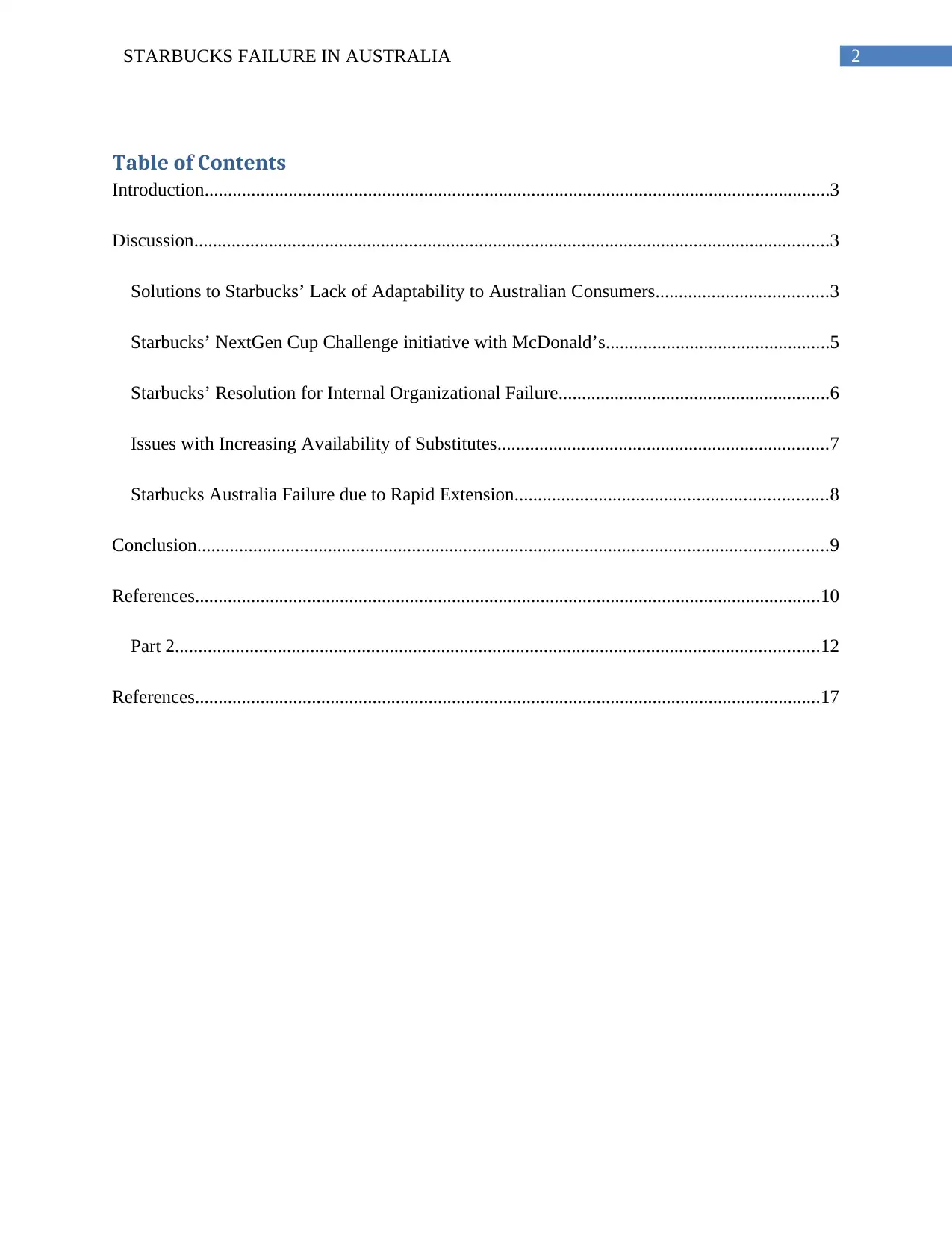
2STARBUCKS FAILURE IN AUSTRALIA
Table of Contents
Introduction......................................................................................................................................3
Discussion........................................................................................................................................3
Solutions to Starbucks’ Lack of Adaptability to Australian Consumers.....................................3
Starbucks’ NextGen Cup Challenge initiative with McDonald’s................................................5
Starbucks’ Resolution for Internal Organizational Failure..........................................................6
Issues with Increasing Availability of Substitutes.......................................................................7
Starbucks Australia Failure due to Rapid Extension...................................................................8
Conclusion.......................................................................................................................................9
References......................................................................................................................................10
Part 2..........................................................................................................................................12
References......................................................................................................................................17
Table of Contents
Introduction......................................................................................................................................3
Discussion........................................................................................................................................3
Solutions to Starbucks’ Lack of Adaptability to Australian Consumers.....................................3
Starbucks’ NextGen Cup Challenge initiative with McDonald’s................................................5
Starbucks’ Resolution for Internal Organizational Failure..........................................................6
Issues with Increasing Availability of Substitutes.......................................................................7
Starbucks Australia Failure due to Rapid Extension...................................................................8
Conclusion.......................................................................................................................................9
References......................................................................................................................................10
Part 2..........................................................................................................................................12
References......................................................................................................................................17
⊘ This is a preview!⊘
Do you want full access?
Subscribe today to unlock all pages.

Trusted by 1+ million students worldwide
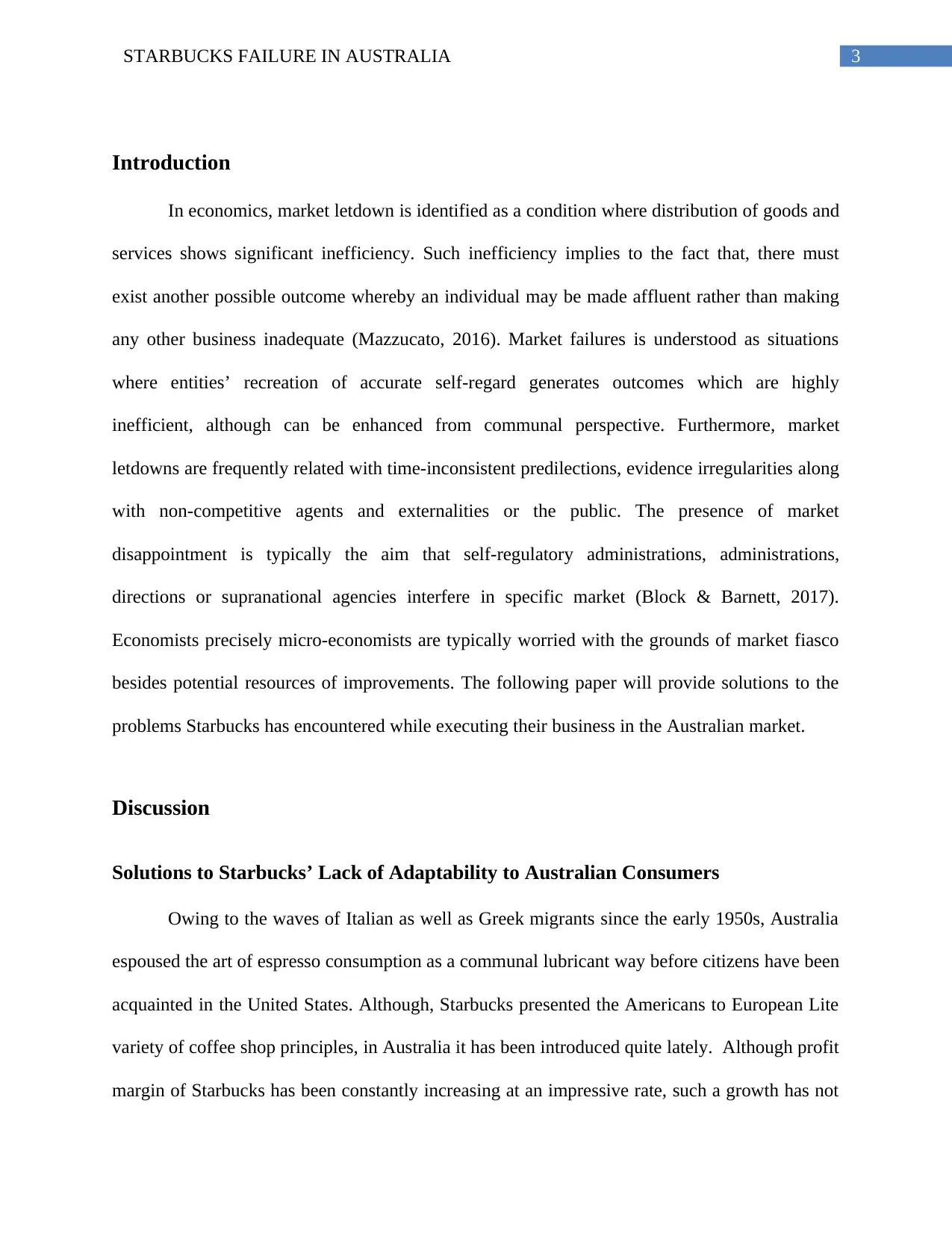
3STARBUCKS FAILURE IN AUSTRALIA
Introduction
In economics, market letdown is identified as a condition where distribution of goods and
services shows significant inefficiency. Such inefficiency implies to the fact that, there must
exist another possible outcome whereby an individual may be made affluent rather than making
any other business inadequate (Mazzucato, 2016). Market failures is understood as situations
where entities’ recreation of accurate self-regard generates outcomes which are highly
inefficient, although can be enhanced from communal perspective. Furthermore, market
letdowns are frequently related with time-inconsistent predilections, evidence irregularities along
with non-competitive agents and externalities or the public. The presence of market
disappointment is typically the aim that self-regulatory administrations, administrations,
directions or supranational agencies interfere in specific market (Block & Barnett, 2017).
Economists precisely micro-economists are typically worried with the grounds of market fiasco
besides potential resources of improvements. The following paper will provide solutions to the
problems Starbucks has encountered while executing their business in the Australian market.
Discussion
Solutions to Starbucks’ Lack of Adaptability to Australian Consumers
Owing to the waves of Italian as well as Greek migrants since the early 1950s, Australia
espoused the art of espresso consumption as a communal lubricant way before citizens have been
acquainted in the United States. Although, Starbucks presented the Americans to European Lite
variety of coffee shop principles, in Australia it has been introduced quite lately. Although profit
margin of Starbucks has been constantly increasing at an impressive rate, such a growth has not
Introduction
In economics, market letdown is identified as a condition where distribution of goods and
services shows significant inefficiency. Such inefficiency implies to the fact that, there must
exist another possible outcome whereby an individual may be made affluent rather than making
any other business inadequate (Mazzucato, 2016). Market failures is understood as situations
where entities’ recreation of accurate self-regard generates outcomes which are highly
inefficient, although can be enhanced from communal perspective. Furthermore, market
letdowns are frequently related with time-inconsistent predilections, evidence irregularities along
with non-competitive agents and externalities or the public. The presence of market
disappointment is typically the aim that self-regulatory administrations, administrations,
directions or supranational agencies interfere in specific market (Block & Barnett, 2017).
Economists precisely micro-economists are typically worried with the grounds of market fiasco
besides potential resources of improvements. The following paper will provide solutions to the
problems Starbucks has encountered while executing their business in the Australian market.
Discussion
Solutions to Starbucks’ Lack of Adaptability to Australian Consumers
Owing to the waves of Italian as well as Greek migrants since the early 1950s, Australia
espoused the art of espresso consumption as a communal lubricant way before citizens have been
acquainted in the United States. Although, Starbucks presented the Americans to European Lite
variety of coffee shop principles, in Australia it has been introduced quite lately. Although profit
margin of Starbucks has been constantly increasing at an impressive rate, such a growth has not
Paraphrase This Document
Need a fresh take? Get an instant paraphrase of this document with our AI Paraphraser
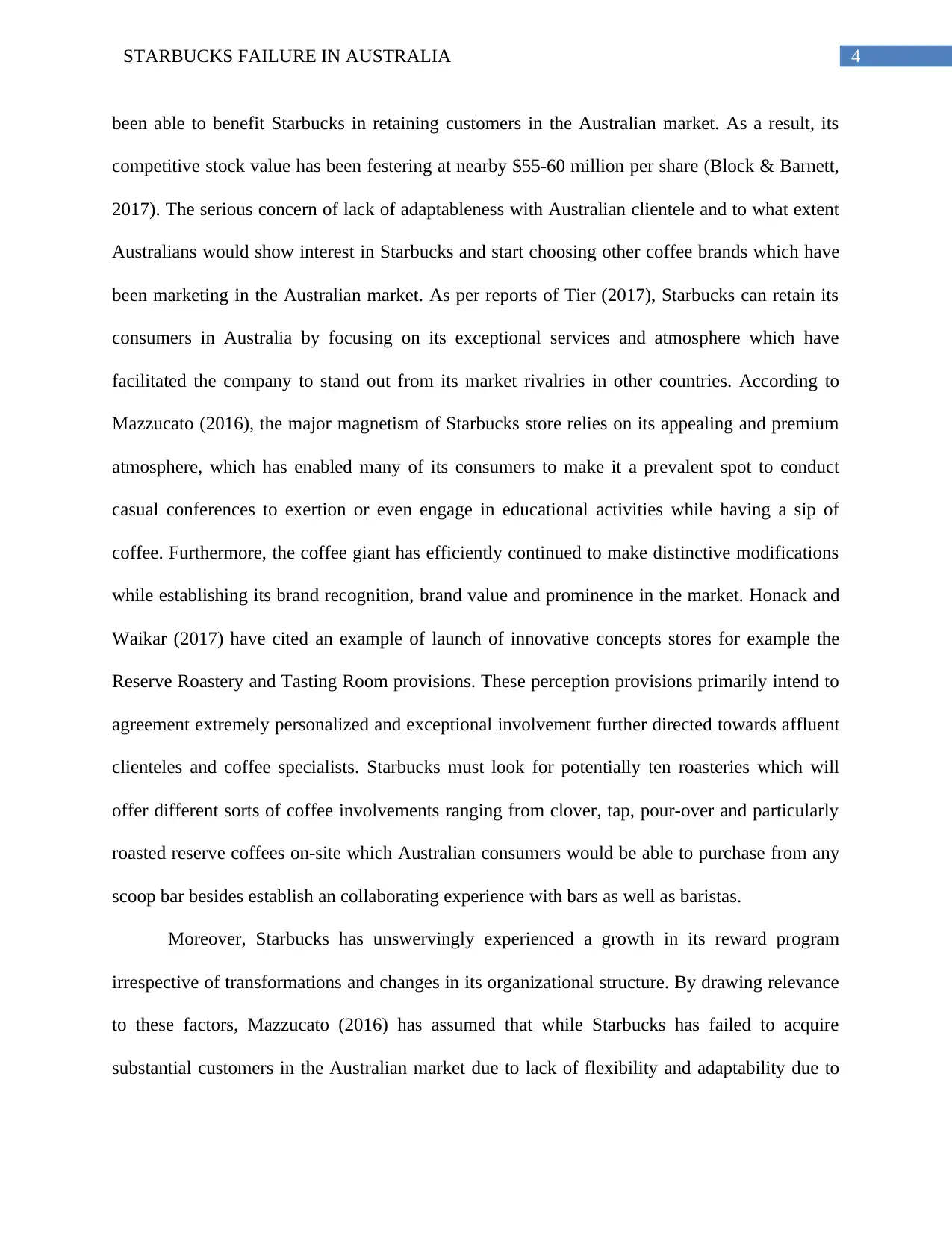
4STARBUCKS FAILURE IN AUSTRALIA
been able to benefit Starbucks in retaining customers in the Australian market. As a result, its
competitive stock value has been festering at nearby $55-60 million per share (Block & Barnett,
2017). The serious concern of lack of adaptableness with Australian clientele and to what extent
Australians would show interest in Starbucks and start choosing other coffee brands which have
been marketing in the Australian market. As per reports of Tier (2017), Starbucks can retain its
consumers in Australia by focusing on its exceptional services and atmosphere which have
facilitated the company to stand out from its market rivalries in other countries. According to
Mazzucato (2016), the major magnetism of Starbucks store relies on its appealing and premium
atmosphere, which has enabled many of its consumers to make it a prevalent spot to conduct
casual conferences to exertion or even engage in educational activities while having a sip of
coffee. Furthermore, the coffee giant has efficiently continued to make distinctive modifications
while establishing its brand recognition, brand value and prominence in the market. Honack and
Waikar (2017) have cited an example of launch of innovative concepts stores for example the
Reserve Roastery and Tasting Room provisions. These perception provisions primarily intend to
agreement extremely personalized and exceptional involvement further directed towards affluent
clienteles and coffee specialists. Starbucks must look for potentially ten roasteries which will
offer different sorts of coffee involvements ranging from clover, tap, pour-over and particularly
roasted reserve coffees on-site which Australian consumers would be able to purchase from any
scoop bar besides establish an collaborating experience with bars as well as baristas.
Moreover, Starbucks has unswervingly experienced a growth in its reward program
irrespective of transformations and changes in its organizational structure. By drawing relevance
to these factors, Mazzucato (2016) has assumed that while Starbucks has failed to acquire
substantial customers in the Australian market due to lack of flexibility and adaptability due to
been able to benefit Starbucks in retaining customers in the Australian market. As a result, its
competitive stock value has been festering at nearby $55-60 million per share (Block & Barnett,
2017). The serious concern of lack of adaptableness with Australian clientele and to what extent
Australians would show interest in Starbucks and start choosing other coffee brands which have
been marketing in the Australian market. As per reports of Tier (2017), Starbucks can retain its
consumers in Australia by focusing on its exceptional services and atmosphere which have
facilitated the company to stand out from its market rivalries in other countries. According to
Mazzucato (2016), the major magnetism of Starbucks store relies on its appealing and premium
atmosphere, which has enabled many of its consumers to make it a prevalent spot to conduct
casual conferences to exertion or even engage in educational activities while having a sip of
coffee. Furthermore, the coffee giant has efficiently continued to make distinctive modifications
while establishing its brand recognition, brand value and prominence in the market. Honack and
Waikar (2017) have cited an example of launch of innovative concepts stores for example the
Reserve Roastery and Tasting Room provisions. These perception provisions primarily intend to
agreement extremely personalized and exceptional involvement further directed towards affluent
clienteles and coffee specialists. Starbucks must look for potentially ten roasteries which will
offer different sorts of coffee involvements ranging from clover, tap, pour-over and particularly
roasted reserve coffees on-site which Australian consumers would be able to purchase from any
scoop bar besides establish an collaborating experience with bars as well as baristas.
Moreover, Starbucks has unswervingly experienced a growth in its reward program
irrespective of transformations and changes in its organizational structure. By drawing relevance
to these factors, Mazzucato (2016) has assumed that while Starbucks has failed to acquire
substantial customers in the Australian market due to lack of flexibility and adaptability due to
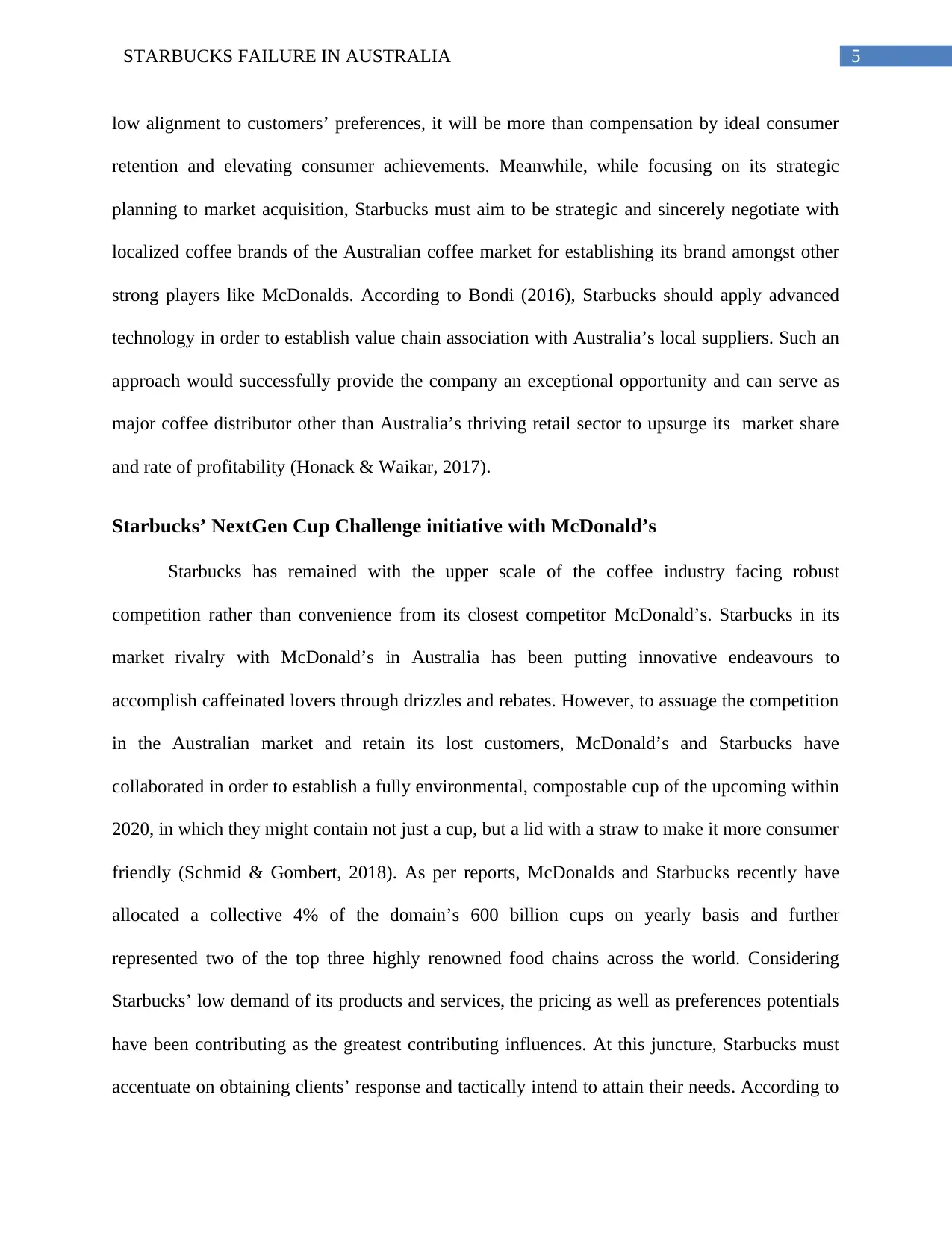
5STARBUCKS FAILURE IN AUSTRALIA
low alignment to customers’ preferences, it will be more than compensation by ideal consumer
retention and elevating consumer achievements. Meanwhile, while focusing on its strategic
planning to market acquisition, Starbucks must aim to be strategic and sincerely negotiate with
localized coffee brands of the Australian coffee market for establishing its brand amongst other
strong players like McDonalds. According to Bondi (2016), Starbucks should apply advanced
technology in order to establish value chain association with Australia’s local suppliers. Such an
approach would successfully provide the company an exceptional opportunity and can serve as
major coffee distributor other than Australia’s thriving retail sector to upsurge its market share
and rate of profitability (Honack & Waikar, 2017).
Starbucks’ NextGen Cup Challenge initiative with McDonald’s
Starbucks has remained with the upper scale of the coffee industry facing robust
competition rather than convenience from its closest competitor McDonald’s. Starbucks in its
market rivalry with McDonald’s in Australia has been putting innovative endeavours to
accomplish caffeinated lovers through drizzles and rebates. However, to assuage the competition
in the Australian market and retain its lost customers, McDonald’s and Starbucks have
collaborated in order to establish a fully environmental, compostable cup of the upcoming within
2020, in which they might contain not just a cup, but a lid with a straw to make it more consumer
friendly (Schmid & Gombert, 2018). As per reports, McDonalds and Starbucks recently have
allocated a collective 4% of the domain’s 600 billion cups on yearly basis and further
represented two of the top three highly renowned food chains across the world. Considering
Starbucks’ low demand of its products and services, the pricing as well as preferences potentials
have been contributing as the greatest contributing influences. At this juncture, Starbucks must
accentuate on obtaining clients’ response and tactically intend to attain their needs. According to
low alignment to customers’ preferences, it will be more than compensation by ideal consumer
retention and elevating consumer achievements. Meanwhile, while focusing on its strategic
planning to market acquisition, Starbucks must aim to be strategic and sincerely negotiate with
localized coffee brands of the Australian coffee market for establishing its brand amongst other
strong players like McDonalds. According to Bondi (2016), Starbucks should apply advanced
technology in order to establish value chain association with Australia’s local suppliers. Such an
approach would successfully provide the company an exceptional opportunity and can serve as
major coffee distributor other than Australia’s thriving retail sector to upsurge its market share
and rate of profitability (Honack & Waikar, 2017).
Starbucks’ NextGen Cup Challenge initiative with McDonald’s
Starbucks has remained with the upper scale of the coffee industry facing robust
competition rather than convenience from its closest competitor McDonald’s. Starbucks in its
market rivalry with McDonald’s in Australia has been putting innovative endeavours to
accomplish caffeinated lovers through drizzles and rebates. However, to assuage the competition
in the Australian market and retain its lost customers, McDonald’s and Starbucks have
collaborated in order to establish a fully environmental, compostable cup of the upcoming within
2020, in which they might contain not just a cup, but a lid with a straw to make it more consumer
friendly (Schmid & Gombert, 2018). As per reports, McDonalds and Starbucks recently have
allocated a collective 4% of the domain’s 600 billion cups on yearly basis and further
represented two of the top three highly renowned food chains across the world. Considering
Starbucks’ low demand of its products and services, the pricing as well as preferences potentials
have been contributing as the greatest contributing influences. At this juncture, Starbucks must
accentuate on obtaining clients’ response and tactically intend to attain their needs. According to
⊘ This is a preview!⊘
Do you want full access?
Subscribe today to unlock all pages.

Trusted by 1+ million students worldwide
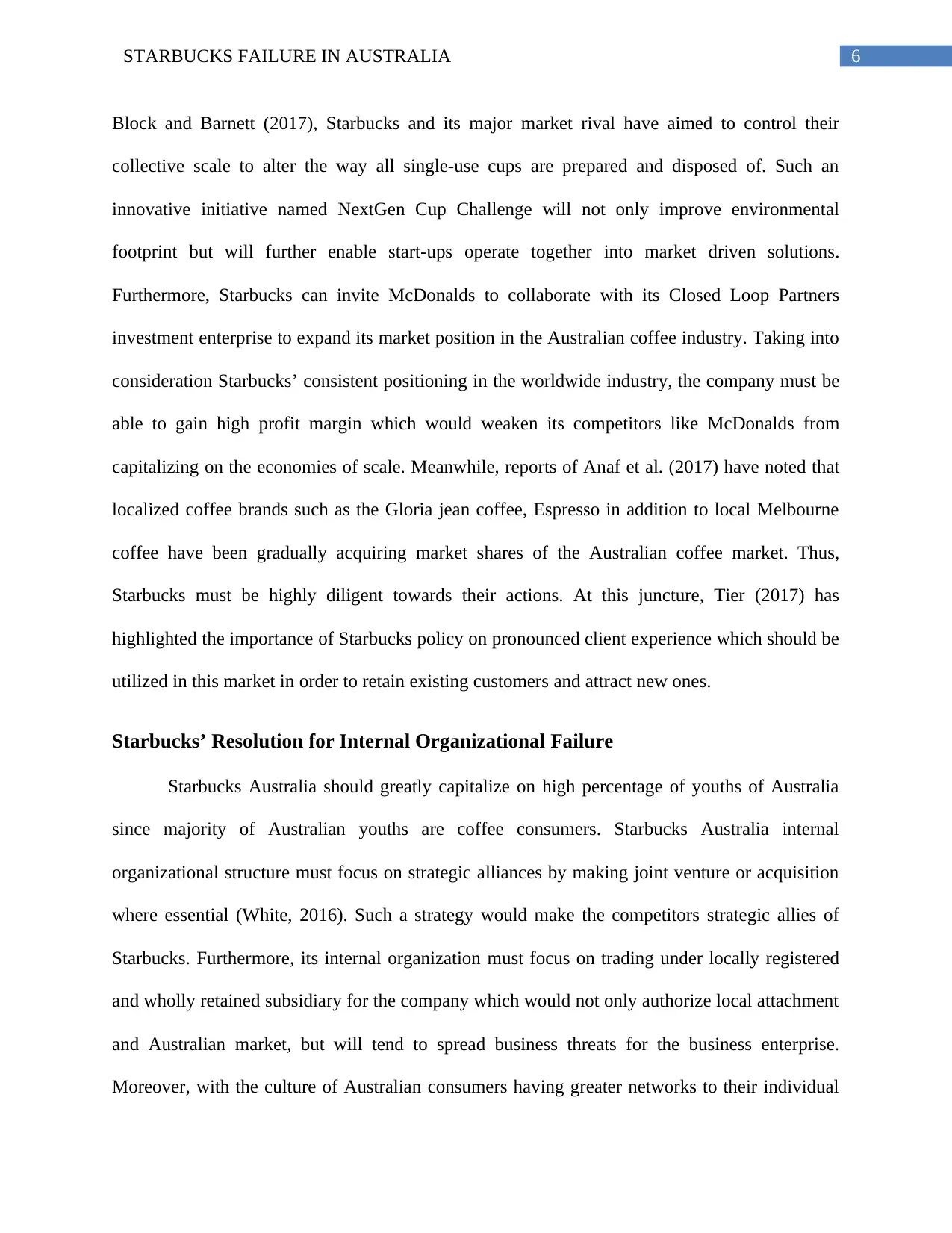
6STARBUCKS FAILURE IN AUSTRALIA
Block and Barnett (2017), Starbucks and its major market rival have aimed to control their
collective scale to alter the way all single-use cups are prepared and disposed of. Such an
innovative initiative named NextGen Cup Challenge will not only improve environmental
footprint but will further enable start-ups operate together into market driven solutions.
Furthermore, Starbucks can invite McDonalds to collaborate with its Closed Loop Partners
investment enterprise to expand its market position in the Australian coffee industry. Taking into
consideration Starbucks’ consistent positioning in the worldwide industry, the company must be
able to gain high profit margin which would weaken its competitors like McDonalds from
capitalizing on the economies of scale. Meanwhile, reports of Anaf et al. (2017) have noted that
localized coffee brands such as the Gloria jean coffee, Espresso in addition to local Melbourne
coffee have been gradually acquiring market shares of the Australian coffee market. Thus,
Starbucks must be highly diligent towards their actions. At this juncture, Tier (2017) has
highlighted the importance of Starbucks policy on pronounced client experience which should be
utilized in this market in order to retain existing customers and attract new ones.
Starbucks’ Resolution for Internal Organizational Failure
Starbucks Australia should greatly capitalize on high percentage of youths of Australia
since majority of Australian youths are coffee consumers. Starbucks Australia internal
organizational structure must focus on strategic alliances by making joint venture or acquisition
where essential (White, 2016). Such a strategy would make the competitors strategic allies of
Starbucks. Furthermore, its internal organization must focus on trading under locally registered
and wholly retained subsidiary for the company which would not only authorize local attachment
and Australian market, but will tend to spread business threats for the business enterprise.
Moreover, with the culture of Australian consumers having greater networks to their individual
Block and Barnett (2017), Starbucks and its major market rival have aimed to control their
collective scale to alter the way all single-use cups are prepared and disposed of. Such an
innovative initiative named NextGen Cup Challenge will not only improve environmental
footprint but will further enable start-ups operate together into market driven solutions.
Furthermore, Starbucks can invite McDonalds to collaborate with its Closed Loop Partners
investment enterprise to expand its market position in the Australian coffee industry. Taking into
consideration Starbucks’ consistent positioning in the worldwide industry, the company must be
able to gain high profit margin which would weaken its competitors like McDonalds from
capitalizing on the economies of scale. Meanwhile, reports of Anaf et al. (2017) have noted that
localized coffee brands such as the Gloria jean coffee, Espresso in addition to local Melbourne
coffee have been gradually acquiring market shares of the Australian coffee market. Thus,
Starbucks must be highly diligent towards their actions. At this juncture, Tier (2017) has
highlighted the importance of Starbucks policy on pronounced client experience which should be
utilized in this market in order to retain existing customers and attract new ones.
Starbucks’ Resolution for Internal Organizational Failure
Starbucks Australia should greatly capitalize on high percentage of youths of Australia
since majority of Australian youths are coffee consumers. Starbucks Australia internal
organizational structure must focus on strategic alliances by making joint venture or acquisition
where essential (White, 2016). Such a strategy would make the competitors strategic allies of
Starbucks. Furthermore, its internal organization must focus on trading under locally registered
and wholly retained subsidiary for the company which would not only authorize local attachment
and Australian market, but will tend to spread business threats for the business enterprise.
Moreover, with the culture of Australian consumers having greater networks to their individual
Paraphrase This Document
Need a fresh take? Get an instant paraphrase of this document with our AI Paraphraser
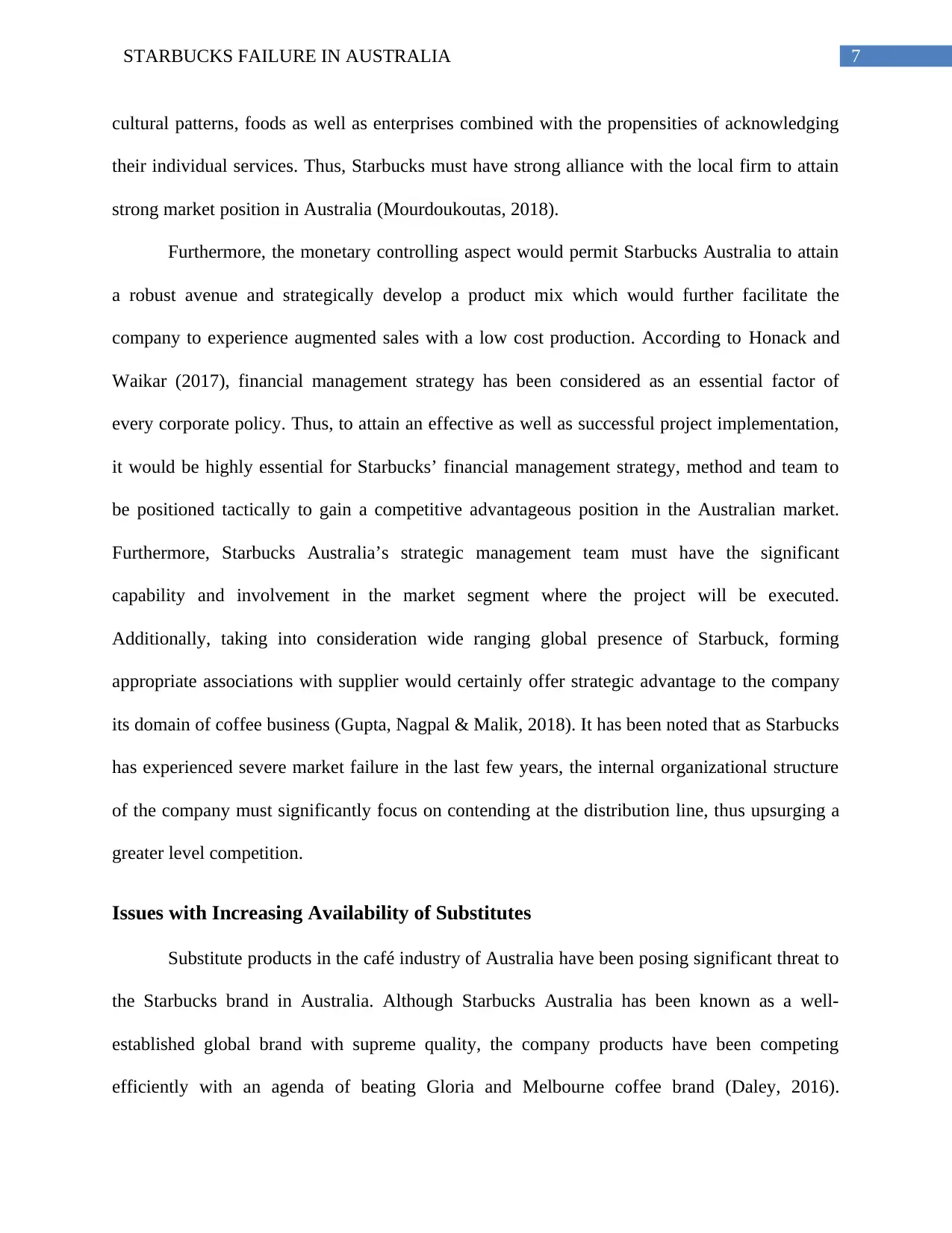
7STARBUCKS FAILURE IN AUSTRALIA
cultural patterns, foods as well as enterprises combined with the propensities of acknowledging
their individual services. Thus, Starbucks must have strong alliance with the local firm to attain
strong market position in Australia (Mourdoukoutas, 2018).
Furthermore, the monetary controlling aspect would permit Starbucks Australia to attain
a robust avenue and strategically develop a product mix which would further facilitate the
company to experience augmented sales with a low cost production. According to Honack and
Waikar (2017), financial management strategy has been considered as an essential factor of
every corporate policy. Thus, to attain an effective as well as successful project implementation,
it would be highly essential for Starbucks’ financial management strategy, method and team to
be positioned tactically to gain a competitive advantageous position in the Australian market.
Furthermore, Starbucks Australia’s strategic management team must have the significant
capability and involvement in the market segment where the project will be executed.
Additionally, taking into consideration wide ranging global presence of Starbuck, forming
appropriate associations with supplier would certainly offer strategic advantage to the company
its domain of coffee business (Gupta, Nagpal & Malik, 2018). It has been noted that as Starbucks
has experienced severe market failure in the last few years, the internal organizational structure
of the company must significantly focus on contending at the distribution line, thus upsurging a
greater level competition.
Issues with Increasing Availability of Substitutes
Substitute products in the café industry of Australia have been posing significant threat to
the Starbucks brand in Australia. Although Starbucks Australia has been known as a well-
established global brand with supreme quality, the company products have been competing
efficiently with an agenda of beating Gloria and Melbourne coffee brand (Daley, 2016).
cultural patterns, foods as well as enterprises combined with the propensities of acknowledging
their individual services. Thus, Starbucks must have strong alliance with the local firm to attain
strong market position in Australia (Mourdoukoutas, 2018).
Furthermore, the monetary controlling aspect would permit Starbucks Australia to attain
a robust avenue and strategically develop a product mix which would further facilitate the
company to experience augmented sales with a low cost production. According to Honack and
Waikar (2017), financial management strategy has been considered as an essential factor of
every corporate policy. Thus, to attain an effective as well as successful project implementation,
it would be highly essential for Starbucks’ financial management strategy, method and team to
be positioned tactically to gain a competitive advantageous position in the Australian market.
Furthermore, Starbucks Australia’s strategic management team must have the significant
capability and involvement in the market segment where the project will be executed.
Additionally, taking into consideration wide ranging global presence of Starbuck, forming
appropriate associations with supplier would certainly offer strategic advantage to the company
its domain of coffee business (Gupta, Nagpal & Malik, 2018). It has been noted that as Starbucks
has experienced severe market failure in the last few years, the internal organizational structure
of the company must significantly focus on contending at the distribution line, thus upsurging a
greater level competition.
Issues with Increasing Availability of Substitutes
Substitute products in the café industry of Australia have been posing significant threat to
the Starbucks brand in Australia. Although Starbucks Australia has been known as a well-
established global brand with supreme quality, the company products have been competing
efficiently with an agenda of beating Gloria and Melbourne coffee brand (Daley, 2016).
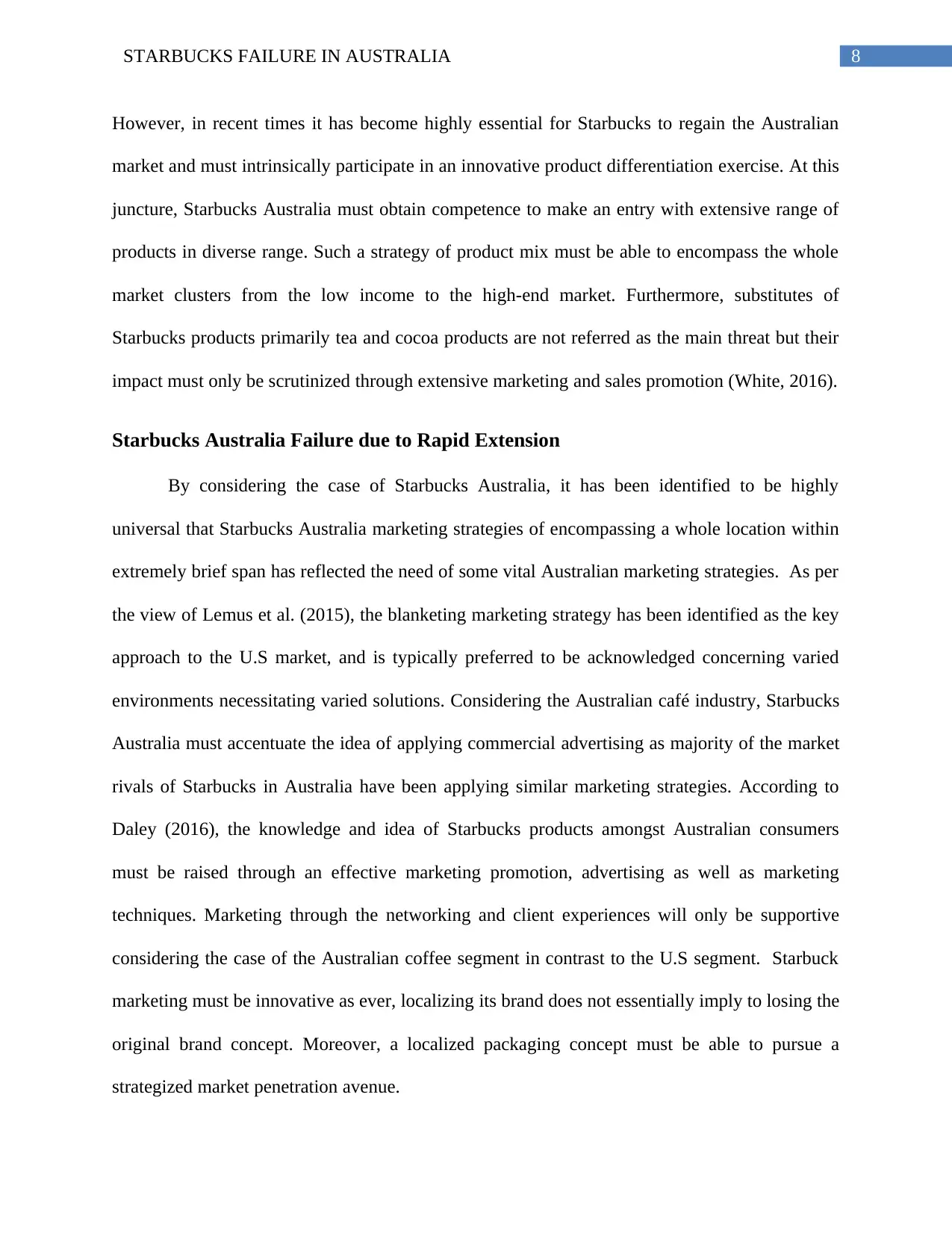
8STARBUCKS FAILURE IN AUSTRALIA
However, in recent times it has become highly essential for Starbucks to regain the Australian
market and must intrinsically participate in an innovative product differentiation exercise. At this
juncture, Starbucks Australia must obtain competence to make an entry with extensive range of
products in diverse range. Such a strategy of product mix must be able to encompass the whole
market clusters from the low income to the high-end market. Furthermore, substitutes of
Starbucks products primarily tea and cocoa products are not referred as the main threat but their
impact must only be scrutinized through extensive marketing and sales promotion (White, 2016).
Starbucks Australia Failure due to Rapid Extension
By considering the case of Starbucks Australia, it has been identified to be highly
universal that Starbucks Australia marketing strategies of encompassing a whole location within
extremely brief span has reflected the need of some vital Australian marketing strategies. As per
the view of Lemus et al. (2015), the blanketing marketing strategy has been identified as the key
approach to the U.S market, and is typically preferred to be acknowledged concerning varied
environments necessitating varied solutions. Considering the Australian café industry, Starbucks
Australia must accentuate the idea of applying commercial advertising as majority of the market
rivals of Starbucks in Australia have been applying similar marketing strategies. According to
Daley (2016), the knowledge and idea of Starbucks products amongst Australian consumers
must be raised through an effective marketing promotion, advertising as well as marketing
techniques. Marketing through the networking and client experiences will only be supportive
considering the case of the Australian coffee segment in contrast to the U.S segment. Starbuck
marketing must be innovative as ever, localizing its brand does not essentially imply to losing the
original brand concept. Moreover, a localized packaging concept must be able to pursue a
strategized market penetration avenue.
However, in recent times it has become highly essential for Starbucks to regain the Australian
market and must intrinsically participate in an innovative product differentiation exercise. At this
juncture, Starbucks Australia must obtain competence to make an entry with extensive range of
products in diverse range. Such a strategy of product mix must be able to encompass the whole
market clusters from the low income to the high-end market. Furthermore, substitutes of
Starbucks products primarily tea and cocoa products are not referred as the main threat but their
impact must only be scrutinized through extensive marketing and sales promotion (White, 2016).
Starbucks Australia Failure due to Rapid Extension
By considering the case of Starbucks Australia, it has been identified to be highly
universal that Starbucks Australia marketing strategies of encompassing a whole location within
extremely brief span has reflected the need of some vital Australian marketing strategies. As per
the view of Lemus et al. (2015), the blanketing marketing strategy has been identified as the key
approach to the U.S market, and is typically preferred to be acknowledged concerning varied
environments necessitating varied solutions. Considering the Australian café industry, Starbucks
Australia must accentuate the idea of applying commercial advertising as majority of the market
rivals of Starbucks in Australia have been applying similar marketing strategies. According to
Daley (2016), the knowledge and idea of Starbucks products amongst Australian consumers
must be raised through an effective marketing promotion, advertising as well as marketing
techniques. Marketing through the networking and client experiences will only be supportive
considering the case of the Australian coffee segment in contrast to the U.S segment. Starbuck
marketing must be innovative as ever, localizing its brand does not essentially imply to losing the
original brand concept. Moreover, a localized packaging concept must be able to pursue a
strategized market penetration avenue.
⊘ This is a preview!⊘
Do you want full access?
Subscribe today to unlock all pages.

Trusted by 1+ million students worldwide
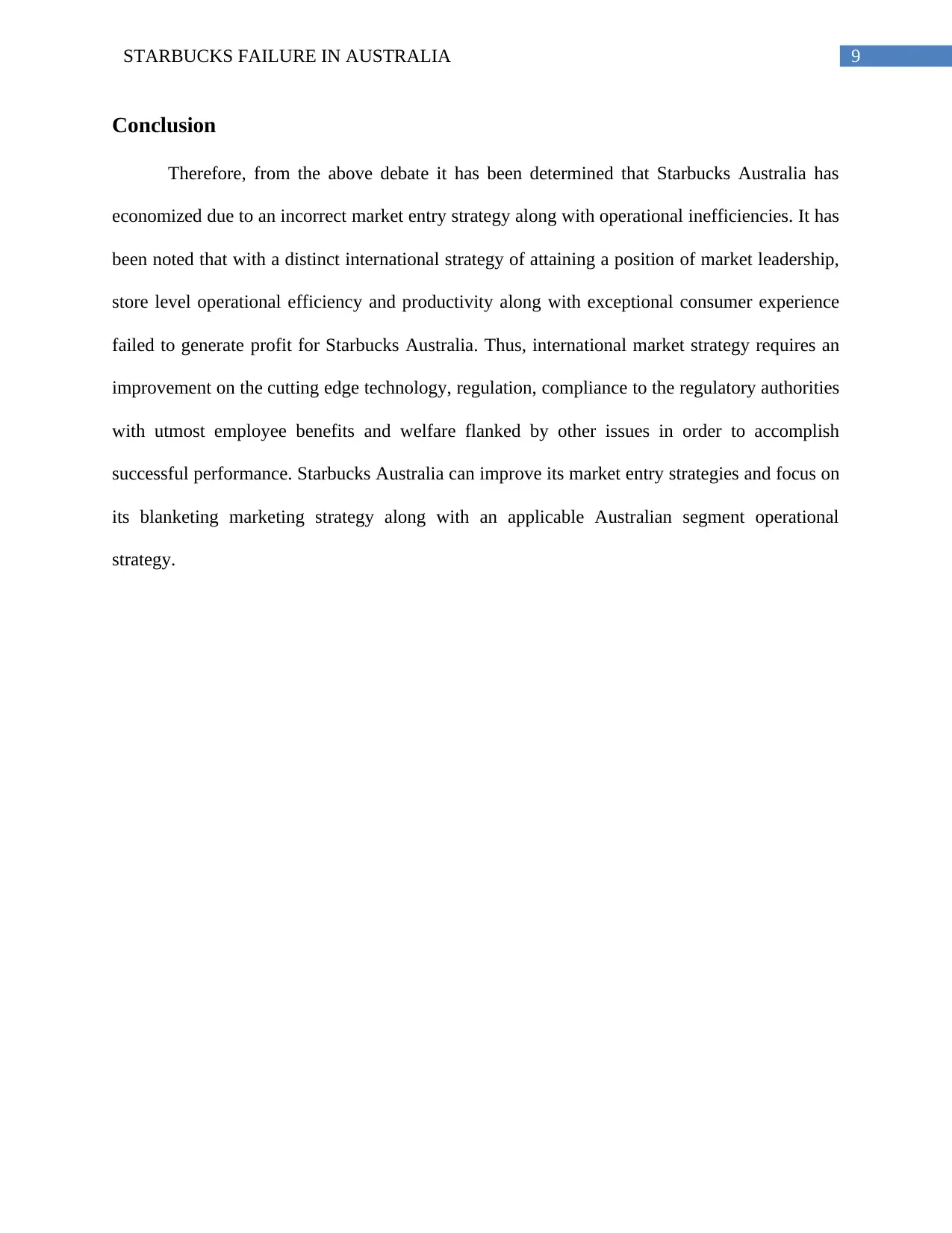
9STARBUCKS FAILURE IN AUSTRALIA
Conclusion
Therefore, from the above debate it has been determined that Starbucks Australia has
economized due to an incorrect market entry strategy along with operational inefficiencies. It has
been noted that with a distinct international strategy of attaining a position of market leadership,
store level operational efficiency and productivity along with exceptional consumer experience
failed to generate profit for Starbucks Australia. Thus, international market strategy requires an
improvement on the cutting edge technology, regulation, compliance to the regulatory authorities
with utmost employee benefits and welfare flanked by other issues in order to accomplish
successful performance. Starbucks Australia can improve its market entry strategies and focus on
its blanketing marketing strategy along with an applicable Australian segment operational
strategy.
Conclusion
Therefore, from the above debate it has been determined that Starbucks Australia has
economized due to an incorrect market entry strategy along with operational inefficiencies. It has
been noted that with a distinct international strategy of attaining a position of market leadership,
store level operational efficiency and productivity along with exceptional consumer experience
failed to generate profit for Starbucks Australia. Thus, international market strategy requires an
improvement on the cutting edge technology, regulation, compliance to the regulatory authorities
with utmost employee benefits and welfare flanked by other issues in order to accomplish
successful performance. Starbucks Australia can improve its market entry strategies and focus on
its blanketing marketing strategy along with an applicable Australian segment operational
strategy.
Paraphrase This Document
Need a fresh take? Get an instant paraphrase of this document with our AI Paraphraser
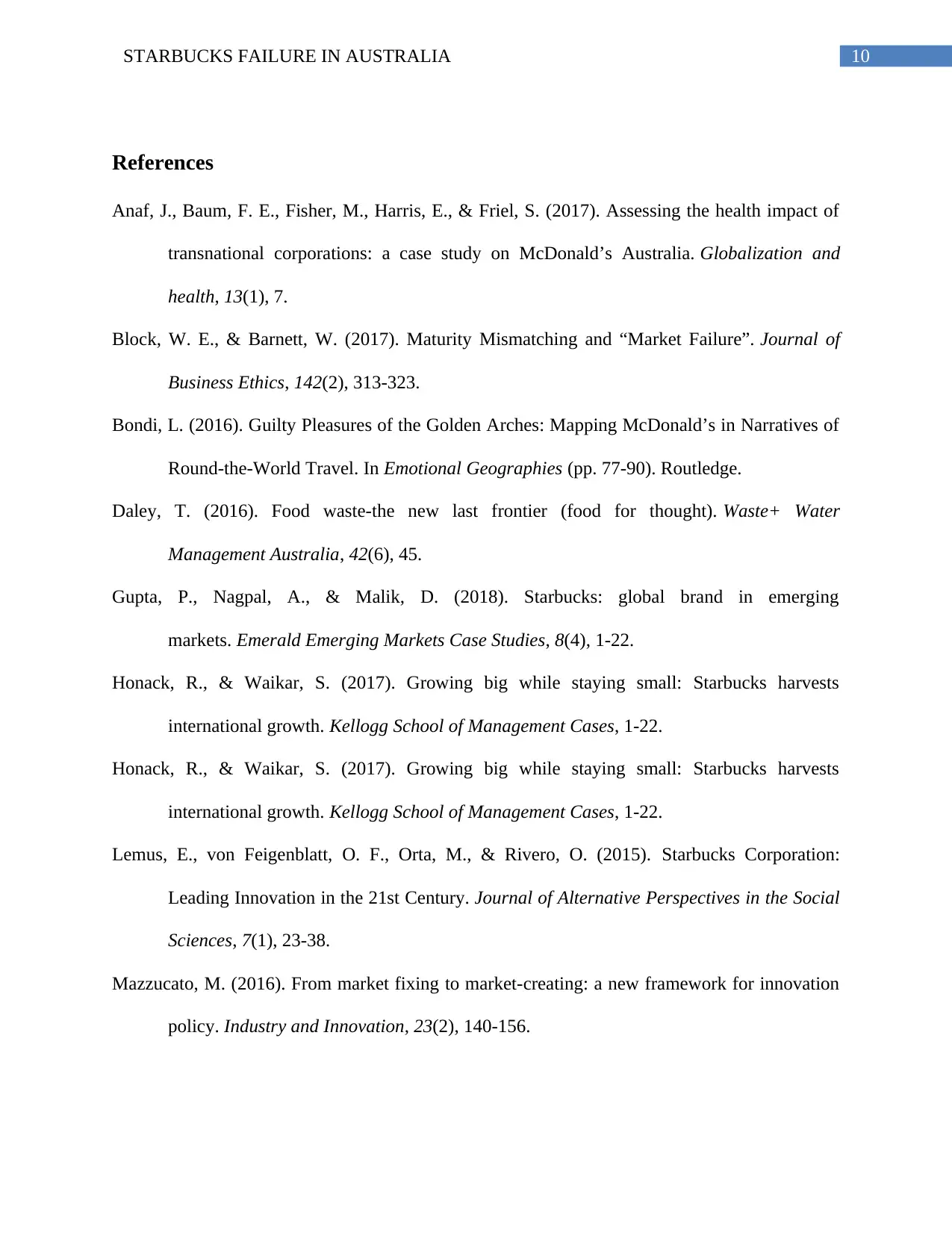
10STARBUCKS FAILURE IN AUSTRALIA
References
Anaf, J., Baum, F. E., Fisher, M., Harris, E., & Friel, S. (2017). Assessing the health impact of
transnational corporations: a case study on McDonald’s Australia. Globalization and
health, 13(1), 7.
Block, W. E., & Barnett, W. (2017). Maturity Mismatching and “Market Failure”. Journal of
Business Ethics, 142(2), 313-323.
Bondi, L. (2016). Guilty Pleasures of the Golden Arches: Mapping McDonald’s in Narratives of
Round-the-World Travel. In Emotional Geographies (pp. 77-90). Routledge.
Daley, T. (2016). Food waste-the new last frontier (food for thought). Waste+ Water
Management Australia, 42(6), 45.
Gupta, P., Nagpal, A., & Malik, D. (2018). Starbucks: global brand in emerging
markets. Emerald Emerging Markets Case Studies, 8(4), 1-22.
Honack, R., & Waikar, S. (2017). Growing big while staying small: Starbucks harvests
international growth. Kellogg School of Management Cases, 1-22.
Honack, R., & Waikar, S. (2017). Growing big while staying small: Starbucks harvests
international growth. Kellogg School of Management Cases, 1-22.
Lemus, E., von Feigenblatt, O. F., Orta, M., & Rivero, O. (2015). Starbucks Corporation:
Leading Innovation in the 21st Century. Journal of Alternative Perspectives in the Social
Sciences, 7(1), 23-38.
Mazzucato, M. (2016). From market fixing to market-creating: a new framework for innovation
policy. Industry and Innovation, 23(2), 140-156.
References
Anaf, J., Baum, F. E., Fisher, M., Harris, E., & Friel, S. (2017). Assessing the health impact of
transnational corporations: a case study on McDonald’s Australia. Globalization and
health, 13(1), 7.
Block, W. E., & Barnett, W. (2017). Maturity Mismatching and “Market Failure”. Journal of
Business Ethics, 142(2), 313-323.
Bondi, L. (2016). Guilty Pleasures of the Golden Arches: Mapping McDonald’s in Narratives of
Round-the-World Travel. In Emotional Geographies (pp. 77-90). Routledge.
Daley, T. (2016). Food waste-the new last frontier (food for thought). Waste+ Water
Management Australia, 42(6), 45.
Gupta, P., Nagpal, A., & Malik, D. (2018). Starbucks: global brand in emerging
markets. Emerald Emerging Markets Case Studies, 8(4), 1-22.
Honack, R., & Waikar, S. (2017). Growing big while staying small: Starbucks harvests
international growth. Kellogg School of Management Cases, 1-22.
Honack, R., & Waikar, S. (2017). Growing big while staying small: Starbucks harvests
international growth. Kellogg School of Management Cases, 1-22.
Lemus, E., von Feigenblatt, O. F., Orta, M., & Rivero, O. (2015). Starbucks Corporation:
Leading Innovation in the 21st Century. Journal of Alternative Perspectives in the Social
Sciences, 7(1), 23-38.
Mazzucato, M. (2016). From market fixing to market-creating: a new framework for innovation
policy. Industry and Innovation, 23(2), 140-156.
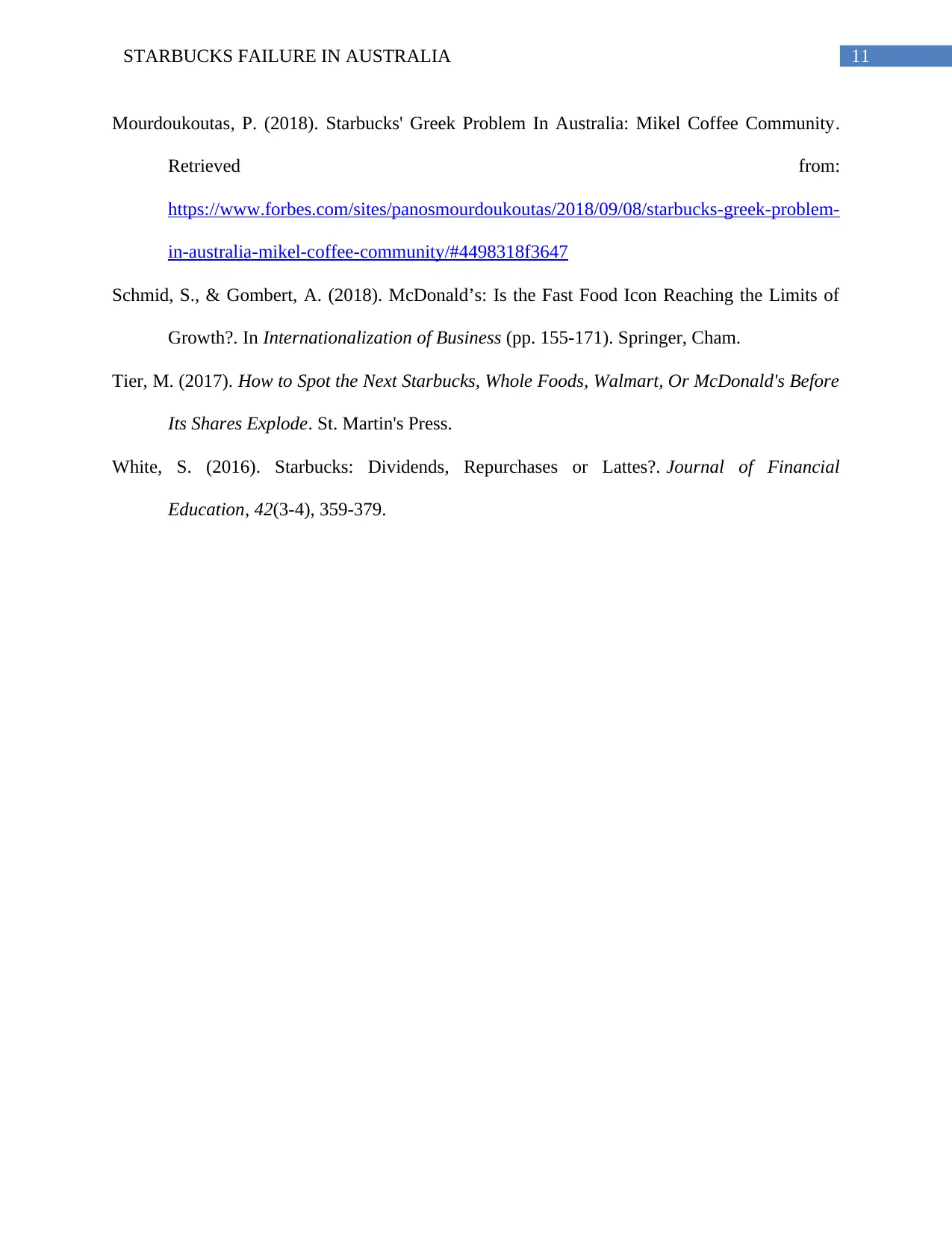
11STARBUCKS FAILURE IN AUSTRALIA
Mourdoukoutas, P. (2018). Starbucks' Greek Problem In Australia: Mikel Coffee Community.
Retrieved from:
https://www.forbes.com/sites/panosmourdoukoutas/2018/09/08/starbucks-greek-problem-
in-australia-mikel-coffee-community/#4498318f3647
Schmid, S., & Gombert, A. (2018). McDonald’s: Is the Fast Food Icon Reaching the Limits of
Growth?. In Internationalization of Business (pp. 155-171). Springer, Cham.
Tier, M. (2017). How to Spot the Next Starbucks, Whole Foods, Walmart, Or McDonald's Before
Its Shares Explode. St. Martin's Press.
White, S. (2016). Starbucks: Dividends, Repurchases or Lattes?. Journal of Financial
Education, 42(3-4), 359-379.
Mourdoukoutas, P. (2018). Starbucks' Greek Problem In Australia: Mikel Coffee Community.
Retrieved from:
https://www.forbes.com/sites/panosmourdoukoutas/2018/09/08/starbucks-greek-problem-
in-australia-mikel-coffee-community/#4498318f3647
Schmid, S., & Gombert, A. (2018). McDonald’s: Is the Fast Food Icon Reaching the Limits of
Growth?. In Internationalization of Business (pp. 155-171). Springer, Cham.
Tier, M. (2017). How to Spot the Next Starbucks, Whole Foods, Walmart, Or McDonald's Before
Its Shares Explode. St. Martin's Press.
White, S. (2016). Starbucks: Dividends, Repurchases or Lattes?. Journal of Financial
Education, 42(3-4), 359-379.
⊘ This is a preview!⊘
Do you want full access?
Subscribe today to unlock all pages.

Trusted by 1+ million students worldwide
1 out of 19
Your All-in-One AI-Powered Toolkit for Academic Success.
+13062052269
info@desklib.com
Available 24*7 on WhatsApp / Email
![[object Object]](/_next/static/media/star-bottom.7253800d.svg)
Unlock your academic potential
Copyright © 2020–2025 A2Z Services. All Rights Reserved. Developed and managed by ZUCOL.